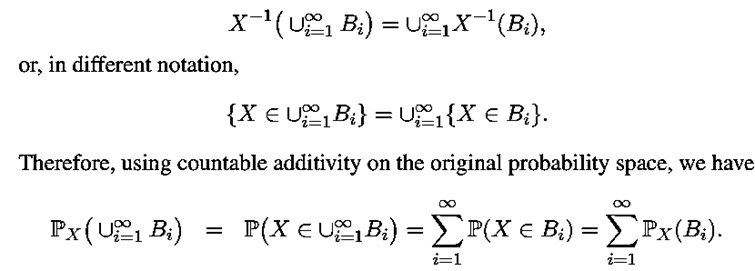The Law Of Random Variable
The law of a random variable: “For a random variable X, the event {ω | X(ω) ≤ c} is often written as {X ≤ c}, and is sometimes just called “the event that X ≤ c.” The probability of this event is well defined, since this event belongs to F. Let now B be a more general
subset of the real line. We use the notation X−1(B) or {X ∈B} to denote the set {ω | X(ω) ∈B}”
- Because the collection of intervals of the form (−∞, c] generates the Borel σ-field in R, it can be shown that if X is a random variable, then for any Borel set B, the set X−1
- (B) is F-measurable. It follows that the probability P X−1
- (B) = P({ω | X(ω) ∈B}) is well-defined. It is often denoted by P(X ∈B).
- Sometimes, PX is also called the distribution of X, not to be confused with the cumulative distribution function defined in the next section. According to the next result, the law PX of X is also a probability measure. Notice here that PX is a measure on (R, B), as opposed to the original measure P, which is a measure on (Ω, F).
- In many instances, the original probability space (Ω, F, P) remains in the background, hidden or unused, and one works directly with the much more tangible probability space (R, B, PX). Indeed, if we are only interested in the statistical properties of the random variable X, the latter space will do.\

Proof: Clearly, PX(B) ≥ 0, for every Borel set B. Also, PX(R) = P(X ∈R) = P(Ω) = 1. We now verify countable additivity. Let {Bi} be a countable sequence of disjoint Borel subsets of R. Note that the sets X−1(Bi) are also disjoint, and that

Discrete random variables:
Discrete random variables take values in a countable set. We need some notation. Given a function f : Ω → R, its range is the set f(Ω) = {x ∈R | ∃ω∈Ωsuch that f(ω) = x}. Discrete random variables and PMFs)
(a)A random variable X, defined on a probability space (Ω, F, P), is said to be discrete if its range X(Ω) is countable.
(b) If X is a discrete random variable, the function pX : R → [0, 1] defined by pX(x) = P(X = x), for every x, is called the (probability) mass function of X, or PMF for short. Consider a discrete random variable X whose range is a finite set C. In that case, for any Borel set A, countable additivity yields
